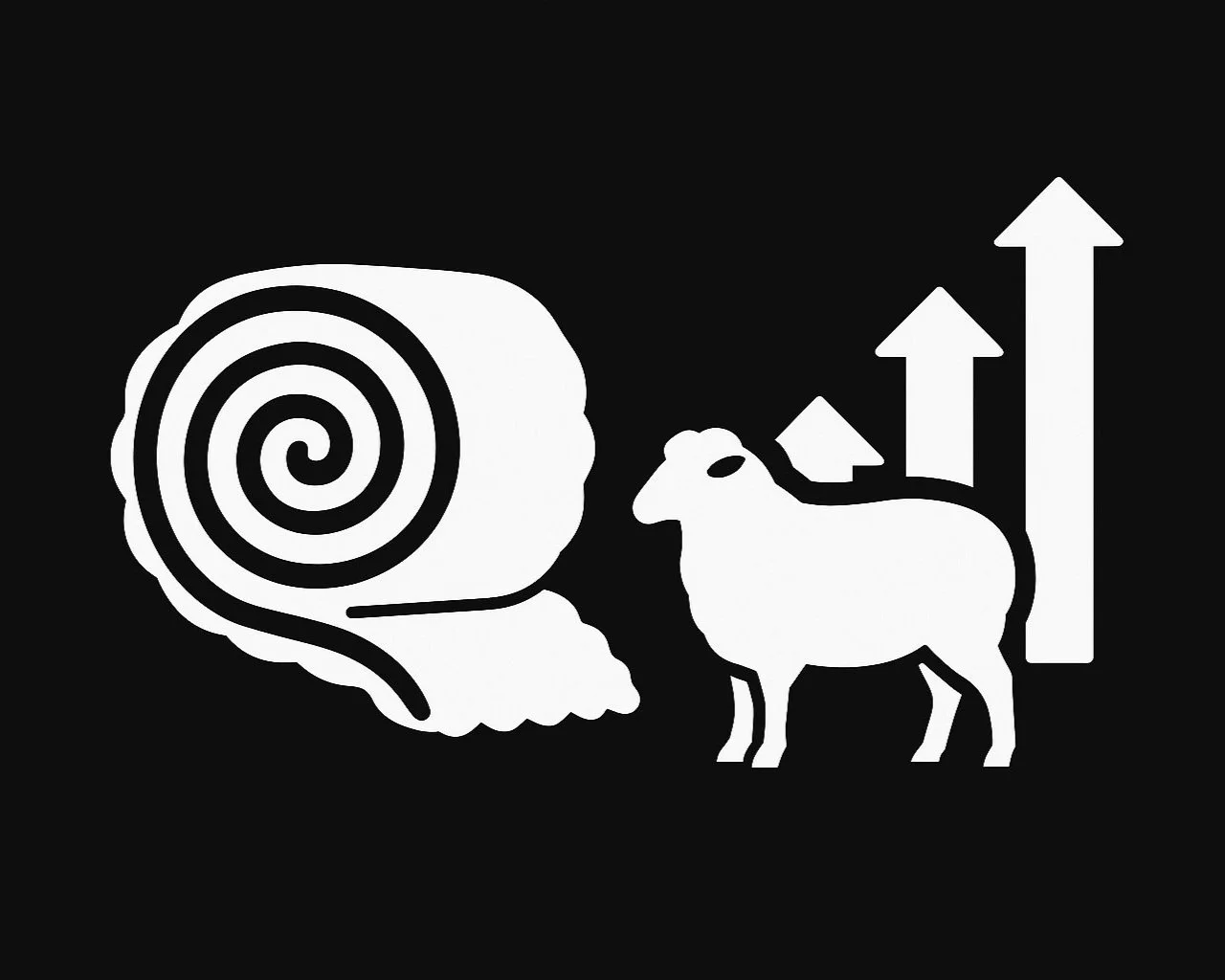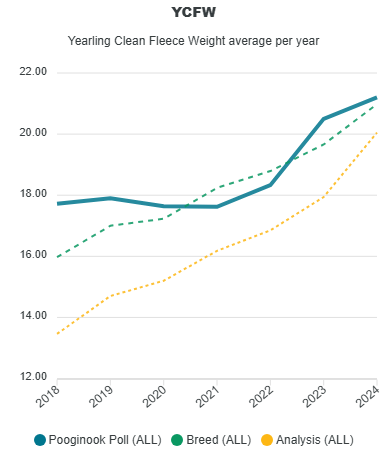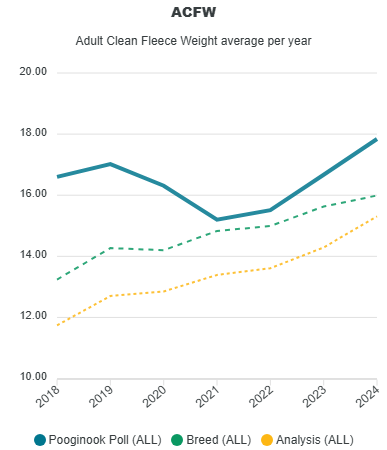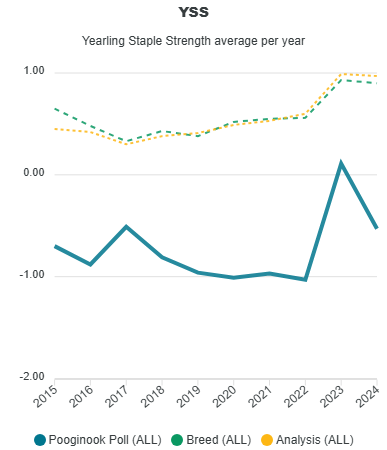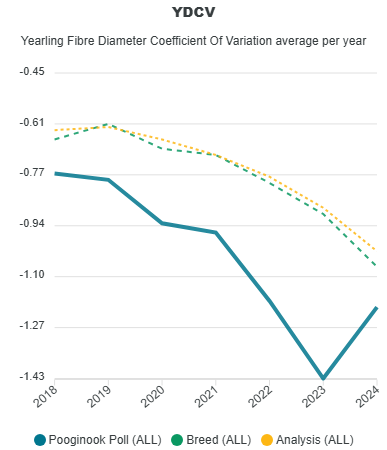Wool Quality & Longevity
Targeted traits:
Fleece Weight, Fibre Diameter, Staple Strength
Overview
Wool remains one of the most valuable outputs in our breeding programme — but it’s not just about cutting volume. The Wool Quality and Longevity pillar focuses on producing fleece that holds its value in real commercial conditions: strong, soft, well-structured fibre that performs over multiple shearings.
We select for fleece weight, fibre diameter, staple strength and consistency, with strict attention to reducing faults like fleece rot, colour, and fibre weakness. The goal isn’t to chase the finest micron or the biggest fleece — it’s to build sheep that cut high-value wool year after year, without compromising structure or resilience.
1. Yearling Clean Fleece Weight (YCFW)
YCFW measures the amount of usable wool produced by a sheep at its first shearing. It’s one of the most direct indicators of fleece productivity and plays a major role in driving wool income across commercial operations.
At Pooginook, we focus on increasing fleece weight without compromising other traits like fibre diameter or staple strength. Our 2030 target is to lift average YCFW above +20% — building sheep that cut more wool, more often, with fewer replacements and greater return per shearing.
2. Adult Clean Fleece Weight (ACFW)
ACFW tracks how much clean wool a sheep produces beyond its first year — a vital indicator of long-term fleece performance and lifetime productivity. It reflects the ability of a ewe to continue cutting valuable wool over multiple shearings, even under variable conditions.
By measuring ACFW, we’re selecting sheep that hold their fleece performance well into maturity. Our 2030 target is to maintain or lift adult fleece weight while continuing to improve fibre structure and longevity — delivering more wool per animal over its working life.
3. Yearling Fibre Diameter (YFD)
Fibre diameter is one of the most critical drivers of wool price. YFD measures the average thickness of a fleece’s fibre at the first shearing — finer fibres typically attract higher prices, but only when balanced with fleece weight, strength and structure.
At Pooginook, we’re not chasing superfine microns — we’re breeding for wool that is fine enough to be valuable, but strong enough to last. Our 2030 target is to maintain an average YFD below <1.5 while continuing to lift fleece weight and reduce fibre faults — building value through balance, not extremes.
4. Yearling Staple Length (YSL)
Staple strength measures how long wool fibres grow over a fixed period, plays major role in processing efficiency, fleece presentation and if considering 6 monthly shearing intervals its of importance to ensure minimum length is achieved. Longer, well structured staples are less prone to breakage during processing, easier to handle and more desirable to processors.
At Pooginook we aim to maintain YSL values between 10-14 while improving weight and maintaining diameter. Our 2023 target is to maintain or slightly improve YSL while paired with strength and structure — so wool not only cuts well but holds together through handling and processing.
5. Yearling Staple Strength (YSS)
Staple strength reflects how durable the wool fibre is — higher strength reduces fleece breakage during processing, improves sale value, and limits wool faults like tenderness or cotting. It’s especially important in areas with seasonal feed variation or fleece stress.
At Pooginook, we’re targeting a lift in YSS across the flock, particularly in balance with fleece weight and fibre length. Our 2030 target is to push average staple strength above zero and maintain consistent processing quality — producing wool that’s not only valuable but reliable across a range of environments.
6. Yearling Fibre Diameter Coefficient of Variation (YDCV)
YDCV measures the evenness of fibre diameter within a fleece. Lower variation means greater consistency — which improves processing performance, yarn quality, and overall marketability. High variability can cause weak points in fibre and reduce fleece value, even if the average micron is fine.
At Pooginook, we’re focused on reducing YDCV while maintaining low average micron and high fleece weight. Our 2030 target is to consistently lower fibre variation across the flock — improving the predictability and quality of every fleece.
7. Late Wool Character (LCHAR)
Wool character refers to the visual and structural quality of the fleece — traits like style, brightness, and handle. While harder to quantify than other measurements, LCHAR is a valuable indicator of how wool holds up over time, especially between shearings or through seasonal stress.
At Pooginook, we assess LCHAR to ensure that our fleeces don’t just measure well — they present well. Our 2030 goal is to consistently maintain strong, stylish wool character in later-season fleeces, helping ensure the clip performs in the market as reliably as it does on paper.
In Summary
Wool traits remain a cornerstone of the Pooginook programme — not just for yield, but for structure, strength and long-term value. By focusing on fleece weight, fibre quality, staple integrity and evenness, we’re building a flock that delivers consistent wool income across multiple shearings. Our 2030 targets are clear: cut more wool, reduce fibre faults, and maintain quality that lasts in the paddock, in the shed, and through the supply chain.

Keep Exploring
Every trait you’ve just read about is part of a bigger picture. If you’re ready to dive deeper, compare your own data, or see how it all connects — keep going.
There’s more to learn, more to apply, and our team’s here to guide you through it.
